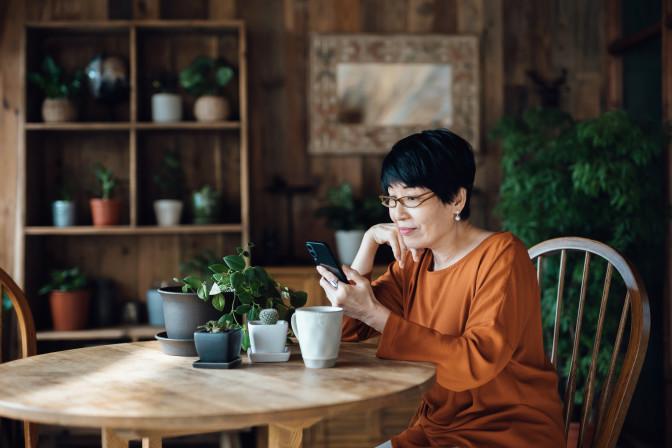Buy one pair of eyeglasses, get a second pair 50% off!
*Restrictions apply. Click here for details.
Is Dark Mode Better for Your Eyes?
Your smartphone may have a “dark mode” or “night mode” setting that alters how your screen looks. It changes most text-based apps from a white background with black text to a black background with white text. Some people like to have their phone set to dark mode at all times, while some only use it at night. Others might never use the setting and stay on “light mode”.
Although you might think the phone’s dark theme is gentler on your eyes, it’s hard to tell if your eyes are truly benefiting from it. The experts at EyeCare Associates are here to help you decide if you should be switching your phone over to dark mode.
Visit the Experts at EyeCare Associates

The eye doctors at EyeCare Associates are here to discuss your eye care concerns and answer any questions you might have about how your phone impacts your eye health. Schedule an eye appointment at an Alabama location near you today.
How Dark Mode May Make Phone Viewing Easier
Many people choose to use dark mode in the evening, when they're outside at night, or when they're sitting indoors in a dark room. Looking at a screen with a dark background may feel more comfortable because you'll see less screen glare. The night-friendly setting reduces the overall brightness output from the screen, providing less contrast with the world around you. Dark mode makes it easier for your eyes to adjust from your dimly lit surroundings to your phone screen. This can reduce eye strain and minimize eye fatigue.
Car navigation systems and GPS devices switch to dark mode after sunset for this reason. It's safer for drivers to glance at a darkened screen while they're traveling along dark roads. Looking at a fully lit GPS would require the eyes to adjust to the brightness, then readjust to darkness when looking back at the road.
Research on the Benefits of Dark Mode
But is dark mode better for your eyes? Very little research has examined the benefits of using dark mode, possibly because of the recency of this feature. Much of the research has focused on dark mode's ability to help people fall asleep more easily at bedtime. This is because it limits the amount of blue light that reaches the eyes in the evening. Blue light from phones mimics sunlight, and it can delay the production of the sleep-inducing hormone melatonin as bedtime approaches. Dark mode has been shown to help encourage nighttime melatonin production.
Spending too much time looking at bright screens throughout the day may lead to digital eye strain, which produces symptoms like eye fatigue or blurry vision. Screen brightness is only one factor — people tend to blink less frequently when looking at screens, which may lead to dry or strained eyes. Blinking more frequently helps reduce symptoms, but no research has shown that looking at devices in dark mode encourages more frequent blinking.
Who May Benefit from Using Dark Mode?
People who spend all day looking at computer and phone screens may benefit the most from using dark mode. You may be at greater risk of eye strain or fatigue if you use devices for several hours every day. Looking at words and images on a darker background may give your eyes needed rest from bright lights and white backgrounds, and it may make it easier to read. This may help prevent or relieve discomfort.
It's important to know that using dark mode alone may not eliminate device-related eye strain or fatigue. Combining this practice with other eye-friendly habits can improve your eye health.
Who May Experience Issues Using Dark Mode?
For people with certain eye conditions, looking at white text on a dark screen may cause a halo effect. A halo effect is when a blur of light surrounds the brightness amid the darkness. This may affect people with myopia (nearsightedness), astigmatism (an irregularity in the curvature at the front of the eye), or presbyopia (an age-related decline in ability to focus on things that are near the eyes).
The halo effect isn't exclusive to smartphones and other digital devices; any bright light that's viewed within a dark field of vision may cause this effect. Some people who have myopia, astigmatism or presbyopia see halos around headlights or streetlights when they drive at night.
If you experience the halo effect when you put your smartphone on dark mode, we don’t recommend using it. You may see things more clearly if you use your device’s regular mode and turn your screen brightness down during the evening.
Schedule an Appointment at EyeCare Associates in Alabama
Deciding which screen mode to use with your devices can be difficult. Get all your questions answered by the experts at an EyeCare Associates location near you. Schedule an appointment today with one of our doctors and feel good about your eye care.
